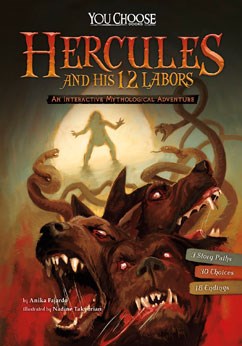Title of the work
Country of the First Edition
Country/countries of popularity
Original Language
First Edition Date
First Edition Details
Anika Fajardo, Hercules and His 12 Labors: An Interactive Mythological Adventure. Mankato: Capstone Press, 2017, 112 pp.
ISBN
Official Website
capstonepub.com (accessed: October 15, 2018)
Genre
Action and adventure fiction
Choose-your-own stories
Didactic fiction
Instructional and educational works
Myths
Target Audience
Children (8–11 years)
Cover

Cover courtesy of Capstone Press.
Author of the Entry:
Tikva Schein, Bar-Ilan University, tikva.blaukopf@gmail.com
Peer-reviewer of the Entry:
Lisa Maurice, Bar-Ilan University, lisa.maurice@biu.ac.il
Susan Deacy, University of Roehampton, s.deacy@roehampton.ac.uk

Anika Fajardo
, b. 1975
(Author)
Anika Fajardo is a writer, editor and teacher originally from Colombia, who spent her childhood in Minnesota from the age of two. She has been writing since elementary school but only realized she wanted to be a writer in her early thirties.
She has written a book on childhood, called Magical Realism for Non-Believers: A Memoir of Finding Family, which is due for publication in 2019.
Sources:
Official website (accessed: October 15, 2018)
Interview at the thelatinoauthor.com (accessed: October 15, 2018)
Bio prepared by Tikva Schein, Bar-Ilan University, tikva.blaukopf@gmail.com

Photo courtesy of the Illustrator.
Nadine Takvorian (Illustrator)
Nadine Takvorian is an American artist from Berkeley, California, USA. She works both as an illustrator and as an author. She produces the illustrations for children's books and graphic novels. She lives in Berkeley, California with her family.
She is the recipient of several awards, including being the Runner up for the SCBWI Martha Weston Grant, 2016 and receiving the Special Jury Award for Animation – South by Southwest Film Festival (SXSW). Her Clients have included Learning A-Z, Capstone Press, Scholastic and others.
Source:
Official website (accessed: October 15, 2018)
Bio prepared by Tikva Schein, Bar-Ilan University, tikva.blaukopf@gmail.com
Summary
This book is a "choose your own adventure" book, inviting the reader to relive the twelve labors of Hercules from a first person perspective, written in the second person, of the persona of the demi-god Hercules. There are three story paths, including a total of thirty junctions at which choices can be made for the reader’s preference. The eighteen optional endings give the reader the possibility to take ownership of the Hercules story and really feel the action themselves. For example, in chapter 2, The Nemean Lion, the lion attacks you and you are asked "how will you protect yourself from this creature?" One is given the option of battling the lion with a sword and dagger, a choice which leads to death; or of battling the lion with a club, which is a successful choice and leads to two more paths.
Hercules, son of the immortal Zeus and mortal Alcmene is pitted against the wrath of Hera, Zeus’ wife, who is jealous of Zeus’ adultery. After Hera tries to ruin Hercules’ life once more, this time by making Hercules kill his family in a fit of insanity, Hercules does penance. He is instructed to serve King Eurystheus for twelve years. The king challenges Hercules to twelve seemingly impossible tasks, the reward for which Hercules can gain immortality.
The book comprises five chapters which relate the twelve tasks of Hercules. The chapters are entitled Becoming a Hero, The Nemean Lion, The Augean Stables, The Amazon Queen and Immortality and they make up the bulk of the book. Fajardo has also included information on ten Greek gods and goddesses; on "other paths to explore", on myths connected to the Hercules myth. The book ends with suggestions for extra reading in books and online together with a glossary, a bibliography and an index.
Analysis
Hercules is presented as an emotive being. He feels anger (p. 14, p. 16, "your blood boils with anger and frustration"), confidence (p. 15, "you are certain you will be able to defeat…"), appreciation (p. 22, "I couldn’t have done it without you, Iolaus"), and gratitude (p. 23, "Just as you are about to thank the villagers"). Hercules has a normal range of emotions, he also experiences annoyance (p. 26) which makes him relatable to children, though anger is more of a recurring theme that one would recommend anyone emulate. However, it is Hercules’ response to his own anger which is important, e.g. "You grit your teeth but stay calm" (p. 48). He is shown as someone driven and goal-orientated (eg. p. 39, "You push forward, all the while thinking of your promise to the gods"). The tale therefore teaches perseverance and ambition.
The reader learns on page 59 from Hercules what it means to be a true hero when we see him able to feed the people of Crete who are starving.
"They eat like they haven’t had a bite to eat in years…you know that by not bringing the bull back to King Eurystheus, you have no fulfilled your labor. But looking out at the happy people, you decide it was worth it. Even without immortality, you truly are a hero."
This angle of sympathy and concern for others characterizes Fajardo’s Hercules as a pleasant character.
The personification of Hercules allows for the reader to identify with a figure of strength, yet also uncertainty. The prescriptive characterisation of Hercules as confidently brave allows a modern audience to relate to this classical figure and identify with him as a positive role model.
The simplicity of the story means that key details are presented scarcely; the author lays her focus on presenting a physical and visual atmosphere such that the reader can imagine herself dynamically performing Hercules’ own labors. The second-person narrative and large amount of dialogue means that one can easily imagine oneself in the place of the protagonist Hercules. Fajardo successfully manages to bring to life Hercules for her target audience of young children.
The full page brown/black/beige illustrations which accompany the story and make up one fifth of the book lend life and vigour to the fast-paced action of the adventure. They depict poses of activity and strength and enable the reader – and invited participant to the action – to visualise the situations more easily.
Fajardo dates the time of this adventure for the reader by beginning with "Life in 400 B.C. is difficult for people in Greece" (p. 7) and then proceeds to give context of Hercules’ status and early days. Place names (Mycenae, Crete) are used without explanation but they are used in such a way that the thread of the narrative carries the reader on regardless.
Fajardo’s rendition of this myth is educative for young children, teaching them that brawn is not the ultimate end-point: e.g. on page 10, "You may be the strongest man in the world, and the prize is right. But you are still half-human". We see that Hercules achieves his labours not merely because of brute strength but because of strategic thinking and wiliness.
By enabling children to take on the persona of Hercules who is fighting against the will of the immortal Olympian Hera, the author is giving children the opportunity to challenge authority.
Furthermore, by starting the book with an acknowledgement of having consulted Dr Laurel Bowman of the Department of Greek and Roman Studies at the University of Victoria, Canada, Farjado places the classical component of the book as being reliable and also important.
The ninth labor given to Hercules involves Hippolyte, queen of the Amazons. She is depicted as threatening to Herucles in that "she is taller…and almost as broad. Her muscles are thick and her eyes are dangerous" (p. 72). As one of the few representations of women in this tale, that of Hippolyte stands in contrast to the tenderness with which Megara and initially Deinara are described.
The alternative endings, some of which include Hercules’ demise, permit the possibility of failure as well as success, though with the power in the reader’s hands. The multiplicity of presentations of these characters offers a lesson to the readership of the complexity of human character – that what you see is not always what you get and different interactions provide different opportunities to see different sides of people’s personalities. This accessibility of mythological life brings the reader into the world of Hercules. Admittedly, the tense clip through the book means that though the action is vivid, it is not rich. However, given the target audience of this book is ages 8–11, the sparsity of description and plot depth is sufficient. The list of Greek gods and goddesses at the end of the book together with the index make this an accessible book for a young person interested in the Classical world.
Further Reading
Hoena, Blake, The 12 Labors of Hercules: A Graphic Retelling. Ancient Myths, North Mankato, Minn,: Capstone Press, 2015.
Powell, Martin, The Adventures of Hercules: A Graphic Novel. Graphic Resolve, North Mankato, Minn.: Stone Arch Books, 2014.
Van Lente, Fred, Hercules. Heroes and Legends, New York: Rosen Publishing, 2015.


